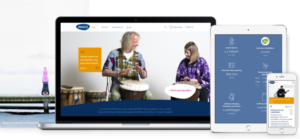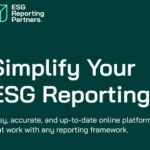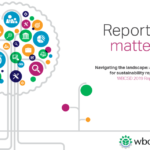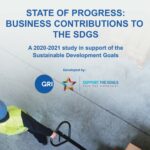
Confronted with an ever-growing demand for transparency and materiality, companies need to find an adequate format to publish both financial and pre-financial information to their stakeholders in an effective way. While traditional reporting reaches its limits, online integrated reporting features a number of key advantages that enable them to get the job done.
It is fair to say that 2017 was an important year for corporate reporting. A number of events established the disclosure of relevant ecological, social and governance (ESG) specific data as the “new normal”:
- Around the world, companies started to strategically align themselves with the UN’s Sustainable Development Goals (SDGs).
- In Europe, the EU Directive 2014/95/EU for “non-financial” reporting, aka “EU NFR Directive”, was transposed into national laws by EU Member States.
- The Task Force on Climate-Related Financial Disclosure (TCFD) and the EU’s High-Level Expert Group (HLEG) on Sustainable Finance both urged for more concise ESG reporting and metrics to enable investors a better-informed decision-making.
- And so did institutional investors, stock exchanges, analysts, index and rating providers.
With these strong tailwinds, traditional corporate reporting is undergoing a transformation. In Europe, many of the approximately 6,000 companies that fall under the new EU NFR Directive will each publish a proper sustainability report in the course of 2018. More companies might even follow suit on a voluntary basis.
Caught up in a reporting jam
However, despite the significant amount of time, resources and costs spent on production, the number of stakeholders flicking through sustainability reports is rather low. Reports show that financial audiences are missing material and forward-looking information they need to assess a company’s performance and their ability to manage future risks. At the same time, the relative importance of annual reports and financial statements is on the decline, as investment professionals and financial analysts increasingly draw on third-party information providers such as Bloomberg Terminal or Thomson Reuters Eikon.
Stunned by a complex reporting landscape and the rising tide in ESG specific data, it becomes increasingly challenging for them to perform effective research and analysis. In an ideal world, they would have one central source to feed them with the input they need to make informed decisions. In the real world, they are confronted with a multitude of information sources different in name, type and content, like Annual Report, CSR Report, Financial Statement, Sustainability Report, Annual Review, Corporate Citizenship Report, or Integrated Report. Even more confusing, sustainability reports often refer to different reporting frameworks like CDP, GRI, SASB, IIRC, UNGP, ISO 26000, guidelines like the SDGs, concepts like the Science-Based Target initiative (SBTi), or a combination of any of these. And unlike financial reporting, a consolidation of the various extra-financial disclosure frameworks into one single standard is not likely to happen in the foreseeable future.
In view of all this complexity, how can a company report on its ability to create financial and societal value in an effective way? How can it reach its key stakeholders and satisfy their particular information needs? Producing separate reports for different audiences often makes it difficult for them to obtain a coherent picture of the business. Simply merging these reports in a single document is not a viable solution either — it would be too bulky and inconvenient to read.
Online integrated reporting to the rescue
Research from Message Group among Europe’s 800 largest companies shows that between 2015 and 2017 the number of businesses publishing financial and extra-financial information in one single integrated report increased by 34 percent, while the number of companies publishing separate sustainability and annual reports decreased by 30 percent. In the same time period, the number of annual reports communicated either partly or fully in HTML format has grown to 41 percent, while the animated interactive PDF format is on its way out.
Against this backdrop, recent developments indicate a growing trend towards online integrated reporting. Unlike stand-alone annual or sustainability reports, online integrated reporting formats put an organization’s financial performance, business strategy and governance into the social, environmental and economic context within which it operates. A well-known example is the Integrated Reporting <IR> framework by the International Integrated Reporting Council (IIRC). Primarily designed for investors, <IR> combines financial and extra-financial information in a single web-based report, focusing on strategy and value creation.
A more recent example for online integrated reporting is the Core & More concept developed by Accountancy Europe in 2015. A presentation model rather than a reporting framework, Core & More promotes the idea of online reporting to a wider audience. Instead of directing readers from a webpage to separate PDF reports and resources located in different online places, Core & More provides all the relevant information on a single multi-layered website.
Investors, employees, customers, regulators, and any other interested stakeholder can hence browse the information most relevant to them more easily. By scrolling up and down the “CORE” page in the top layer, they are presented with key information such as the CEO statement, key success indicators, and the company’s most material business drivers such as innovation, energy consumption, or workforce, for example. A structured summary at the top of the page directs them to a layer with “MORE” specific information about financial, environmental and social aspects. This is where investors can dig deeper into financial statements, stakeholder engagement, global market trends, or an investor relations section.
Putting the reader back center stage
Compared to traditional reporting methods, HTML offers a maximum of flexibility in terms of structure, format and style. It allows for hierarchical, faceted or hybrid navigation via menus, tabs, layers, links. It combines text with either static or interactive graphs and tables. It can also adapt and change between a more informative, narrative, or factual style, depending on the content, section, and the related audience. In doing so, online integrated reporting is able to strike a balance between financial and non-financial stakeholders. Moreover, it is flexible enough to integrate multiple reporting frameworks, accounting standards and concepts, such as the International Financial Reporting Standard (IFRS) in combination with GRI, <IR>, the TCFD recommendations, or the SDGs. On top of all this flexibility, a digital reporting format is highly interactive and customizable, allowing the reader to create charts or compile selected content into personal PDF or printed reports.
Let’s take a look at the example of Munich Airport, a privately-owned company that published its first online integrated report in 2017. It enables stakeholders to compare the key performance figures from different years in an interactive diagram.
In one single view, readers can visualize the development of material parameters such as financial (e.g. EBITDA, EBIT, EAT), ecological (e.g. CO2 emissions total, from direct/indirect energy consumption, per passenger), and social (e.g. service quality, employees). Each section of the digital report displays a “Store the Page” tab on the sidebar, inviting readers to compose a custom PDF report with information most relevant to them. Another tab directs to the index list of the corresponding reporting framework, in this case, GRI.
Furthermore, there is a trend towards continuous reporting of non-audited information. Dutch government agency ProRail in the Netherlands, for example, displays a dashboard that shows the organization’s key performance indicators such punctuality of passenger and freight trains, the number of cancellations, high impact failures and collisions, or environmental offenses. The dashboard is automatically updated every 24 hours. Interactive charts and dynamic content spur the dialogue with stakeholders, keeping the corporate report relevant throughout the year.
To assure the validity of audited data, IT solutions giant SAP provides the option of downloading a formally assured report in PDF format. On top of that, all audited content in its online integrated report is clearly indicated and tagged by an “Audited” checkmark.
Some companies such as Dutch energy network operator Alliander go one step further by designing their online integrated report in a proper content management system. They then draw on this central online source to publish parts of the content to multiple media such as PC, smartphone or tablet, and for other types of publications such as KPIs, quarterly statements or annual reviews. This “online first” reporting approach leverages APIs to synchronize digital information with source files from databases or Excel to feed interactive diagrams, charts and tables. Web analytics enable the company to better understand their audience, their navigation behavior, preferences, and thus the ability to optimize the content and structure of its reporting over time.
By leveraging the same web content management platform, PDF templates and trained internal resources for consecutive annual reports, companies can reduce both the production costs and the risk of flaws. The ability to automate collaboration, data consolidation and publication processes in a secured central environment eventually make “online-first” a safe and efficient option for corporate reporting.
Machine-readable XBRL adding momentum
An additional driving force for online reporting is the mandatory filing of annual reports in machine-readable format. As from 2020, the European Securities and Markets Authority (ESMA) requires consolidated financial statements filed by EU listed companies according to the IFRS to be filed in eXtensible HyperText Markup Language (XHTML) and inline “EXtended Business Reporting Language”(XBRL). The new European Single Electronic Format (ESEF) would make it possible to automatically access, identify and extract both numbers and narrative information. Reports in XHTML format can be opened with any web browser, the inherent XBRL information will be accessible to the public. Investors can use it either directly or indirectly through data aggregators and services. Framework providers such as GRI and CDP have adopted the XBRL taxonomy already.
According to the ESMA, around 5,300 corporations are affected throughout Europe. As a consequence, broad adoption of HTML as a standard format for annual reporting seems to be inevitable. At the first stage, companies will only be required to map their core financial information such as the balance sheet, profit and loss statement, cash-flow and statement of changes in equity. While in the U.S. listed companies are mandated by the Securities and Exchange Commission (SEC) to file all financial information in machine-readable format, public companies in India already need to provide certain ESG information in this manner. Once implemented in the EU, the IFRS might serve as a reference point for further regulatory initiatives to make corporate reporting more accessible, transparent and comparable.
Turning reporting into a powerful communications tool
In view of growing demand for ESG disclosure, the related surge in sustainability reporting, and a complex reporting landscape companies are challenged to find a disclosure format for both financial and extra-financial information that has a measurable value for their key stakeholders. The answer lies in form and function. By publishing material information on a discrete website, online integrated reporting is making the best use of digital capabilities. It allows for high flexibility in terms of content structure, format and style, effective navigation, the integration of infographics, video, interactive diagrams and animations, the synchronization with source databases, and the output to various media.
Used effectively, online integrated reporting makes corporate disclosure more accessible, coherent, dynamic, comparable, interactive, and thus more user-friendly and effective. To financial stakeholders, it might be appreciated as a source of authentic, relevant and reliable information, and hence become a welcome alternative to traditional annual reports. By showing them how a company creates value rather than just money, online integrated reporting helps tell the story about its corporate strategy. Synergies between corporate communications, investor relations and marketing communications leads to further alignment, greater consistency, and hence an increase in credibility and impact.
Online integrated reporting is leading to a new comprehensive and dynamic landscape, breaking away from the silos of separate financial and “non-financial” reports. These are getting transformed from distinct projects whose ownership was confined to financial and sustainability departments to a cross-functional project, from a statement of past performance to a strategic document, and from a compliance exercise to a smart and powerful communications tool.
Michael Laermann (originally published on SustainableBrands.com on February 15, 2018).
As freelance consultant, Michael is working at the intersection of business and sustainability, helping companies build integrated communications strategies to drive sustainable growth. Michael is working out of Brussels, Belgium, speaks 5 languages, and is passionate about outdoor sports.



